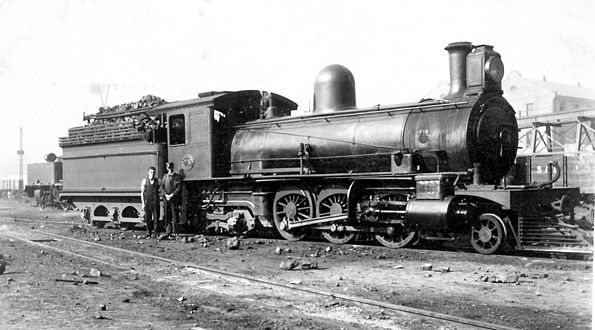CGR class 6 (No. 270-277)
| CGR class 6 (No. 270-277) SAR class 6Z |
|
|---|---|
|
CGR class 6 (No. 270-277)
|
|
| Numbering: | SAR: 713-720 |
| Number: | 8th |
| Manufacturer: | Neilson Reid |
| Year of construction (s): | 1901-1902 |
| Type : | 1'C1 'n2 or 1'C2' n2 |
| Gauge : | 1067 mm ( cape track ) |
| Length over coupling: | 16,948 mm |
| Service mass: | 55.3 t |
| Service mass with tender: | 88.5 t |
| Wheel set mass : | 13.0 t |
| Driving wheel diameter: | 1,372 mm |
| Cylinder diameter: | 457 mm |
| Piston stroke: | 660 mm |
| Boiler overpressure: | 117.1 N / cm² |
| Grate area: | 2.37 m² |
| Train brake: | Suction air brake |
The vehicles assigned to class 6 with track numbers 270 to 277 of Cape Government Railways (CGR) were steam locomotives with a tender with the wheel arrangement 1'C1 '( Prairie ) and 1'C2' ( Adriatic ).
history
With the class 6 introduced in 1893, numerous locomotives with the 2'C ( ten-wheeler ) wheel arrangement were in service with the CGR . It was clear to the then Chief Mechanical Engineer of the CGR, HM Beatty, that much more powerful boilers could not be realized with this axis arrangement because there was no space for a wide standing boiler between the coupling wheels. He therefore designed a comparably large locomotive with a running axle under the standing boiler and a frame cranked around it. The grate area could thus be increased from 1.56 to 2.37 m².
Since the engine should not be greater than the 2'C- "Standard locomotives" Class 6 was held by a leading bogie a bissel provided. Axle load and total weight were still a bit larger.
Neilson Reid supplied four locomotives with the 1'C1 'wheel arrangement in 1901, the first with this wheel arrangement in South Africa and, in addition to the machines with the numbers 901 and 902 delivered in 1903, the only ones. However, they did not keep this axle arrangement for long, because the design of the trailing axle turned out to be unsatisfactory - it was firmly mounted in the frame and too immobile. The locomotives were therefore provided with a bogie under the standing boiler, which resulted in the 1'C2 'wheel arrangement, which is unique in South Africa. Four more locomotives were purchased in this form in 1902.
Initially, the machines were used on main routes, later they migrated to suburban traffic, where they proved their worth.
The SAR took over all eight locomotives as class 6Z with the track numbers 713 to 720. They were retired by 1934; no copy has survived.
More pictures
Especially in the second picture you can clearly see the rear bogie under the standing boiler.
literature
- Leith Paxton, David Bourne: Locomotives of the South African Railways. A Concise Guide. C. Strui (Pty) Ltd., Cape Town 1985, ISBN 0-86977-211-2 .


